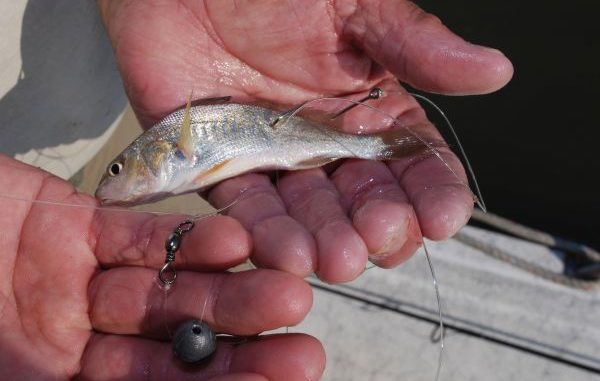
Capt. Zutie Auenson shares his thoughts on how to target big 5- and 6-pounders
Grand Isle is known for producing lots of smaller speckled trout, but one guide zeroes in on bigger specks using Carolina-rigged live croakers.
In this excerpt from Trout Masters Too: How the pros do it, Capt. Carol ‘Zutie’ Auenson with Bay Coast Charters shares his tips and tactics to target 5- and 6-pounders.
Here are his thoughts:
Although Auenson loves to use soft plastics on jigheads, his charter business for speckled trout at Grand Isle is built around using live croakers as bait. He feels that croakers offer some versatility that other live baits and plastics don’t have. “You can catch specks in murky water with croakers because they make croaking noises,” he explains.
Auenson usually hooks his croakers through the flesh beneath the rear of the dorsal fin. He will also occasionally jab the hook through the baitfish’s lips, but he feels croakers swim more actively when hooked through the back.
He uses a delicate touch with his rod, very slowly and gently jigging and retrieving the slack. He is always in touch with his bait. Instead of striking immediately when he feels a trout bump the croaker, he will set the hook only when he feels that the fish has the bait fully in its mouth.
His basic rig for fishing live croakers is a Carolina rig, an 18-inch leader with a 3/0 kahle hook on one end and a swivel on the other. Threaded on the main line above the swivel is normally a 1/2-ounce egg sinker, although he will use a 3/4-ounce weight if the surf is rough and he has to make longer casts to reach his favored fishing spots near the beach.
The leader is 30-pound-test monofilament. “Nothing special like fluorocarbon,” he says. “I just don’t see no difference, and (mono is) a lot cheaper.”
Auenson uses plastics on 1/4-ounce jigheads secondarily to live bait. He keeps his selections simple, his favorite being smoke/glitter split-tail beetles. Other colors he uses include glow, white and blue moon. On occasion, he will also use plastic cocahoe minnow-type lures and straight-tails.
He may or may not use an 18-inch shock leader tied line to line when he fishes with jigs. If he doesn’t, he reties frequently. Plastics are useful in places with too many obstructions to fish Carolina rigs, such as near rock rip-rap. He fishes plastics using a slow, steady retrieve with an occasional twitch.
Auenson also always keeps a rod rigged with plastics for fishing under birds. While he quickly admits he isn’t crazy about fishing under diving birds in bays and lakes, he will stop to fish them along the beaches because the schools don’t move as much as do those inside. He cautions, however, to know the difference between “liar birds,” as he calls smaller terns, “which are always dipping and diving,” and larger gulls that only dive in groups on feeding fish.
He also uses plastics on jigs to find fish because he can cover a lot of water with them. But when he finds trout, he picks up a rod with a Carolina rig and a croaker on it. “You can catch more,” he says, “and you catch bigger fish. You gotta remember that I like bigger fish.”
Auenson’s favorite reels are Shimano Curado baitcasting reels, which he fills with 15-pound-test Berkley Big Game monofilament line. “Some people like that braided line,” he says. “I don’t. It has no stretch and you can pull the hook out of their mouth.”
Learn more about how the best guides and anglers across the Louisiana coast catch trout day in, day out by purchasing the Trout Masters Tool Kit, which includes a special package price for Trout Masters: How Louisiana’s Best Anglers Catch the Lunkers and Trout Masters Too: How the pros do it.


